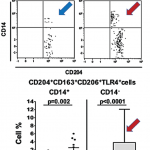Juvenile (5 weeks old) and young adult (13 weeks old) rats were immunized with an emulsion of bovine type II collagen/incomplete Freund’s adjuvant to induce arthritis. Maximum Daily Arthritis Index scores and weight were measured daily. Blood and tissue samples were taken 14 days after arthritis onset when the rats were euthanized. At onset, both groups of rats showed acute inflammation, Dr. Wilson-Gerwing said. At 14 days, the juvenile rats showed signs of good resolution of inflammation. The young adult rats had higher inflammation and more joints involved, she said. Adult rats also showed more ankle thickness, but a decrease in toe spread compared with the juveniles. Adult rats also had more low-density bone. Juvenile rats had lower levels of the cytokine IL-10 and higher levels of the chemokine fractalkine, she said.
The young adult rats had higher levels of pro-inflammatory HMGB1, and RAGE, while the juveniles had higher levels of GPR32 and FPR2. Before arthritis exposure, adult rats have higher levels of RAGE and may be primed for inflammation, she said. Juveniles may be better equipped to fight inflammation than young adult rats with CIA, said Dr. Wilson-Gerwing. The anti-inflammatory effects of endogenous resolvins are mediated by impeding the production of HMGBI, she concluded.
Pathogenesis of Arthritis
In another abstract presentation, Isao Matsumoto, MD, PhD, a researcher at the University of Tsukuba in Japan, discussed how “TIARP Attenuates Autoantibody-Mediated Arthritis via the Suppression of Neutrophil Infiltration into the Joint.”11
The study’s purpose was to discover how TIARP, or TNFα-induced adipose-related protein, plays a role in arthritis pathogenesis, especially through neutrophils and fibroblast-like synoviocytes, through which the protein is expressed, said Dr. Matsumoto.
Serum arthritis was induced in TIARP-knockout and wild-type mice. Arthritis in the TIARP-deficient mice was spontaneous and markedly severe, with no autoantibody production, and was IL-6-dependent, he said. Recruitment of neutrophils into the ankle joint was significantly enhanced, which they considered a crucial sign.
Genetic analysis showed that CXCR1 and CXCR2 were both clearly upregulated in the knockout mice’s neutrophils. Expressions of CXCL2 and IL-6 were also higher in the knockout mice’s fibroblast-like synoviocytes. Trans-well assay confirmed the importance of the neutrophil-FLS interaction in these mice.
When the researchers added an anti-CXCL2 Ab, neutrophil migration was significantly reduced. The blockade of IL-6R signaling attenuated the arthritis, and markedly reduced neutrophil migration into the joints, he said.
TIARP may downregulate expression of CXCR1 and CXCR2 in neutrophils, as well as reducing the production of CXCL2 in fibroblast-like synoviocytes, said Dr. Matsumoto. This results in the protective ability of neutrophil migration through the inhibition of IL-6 signaling.
